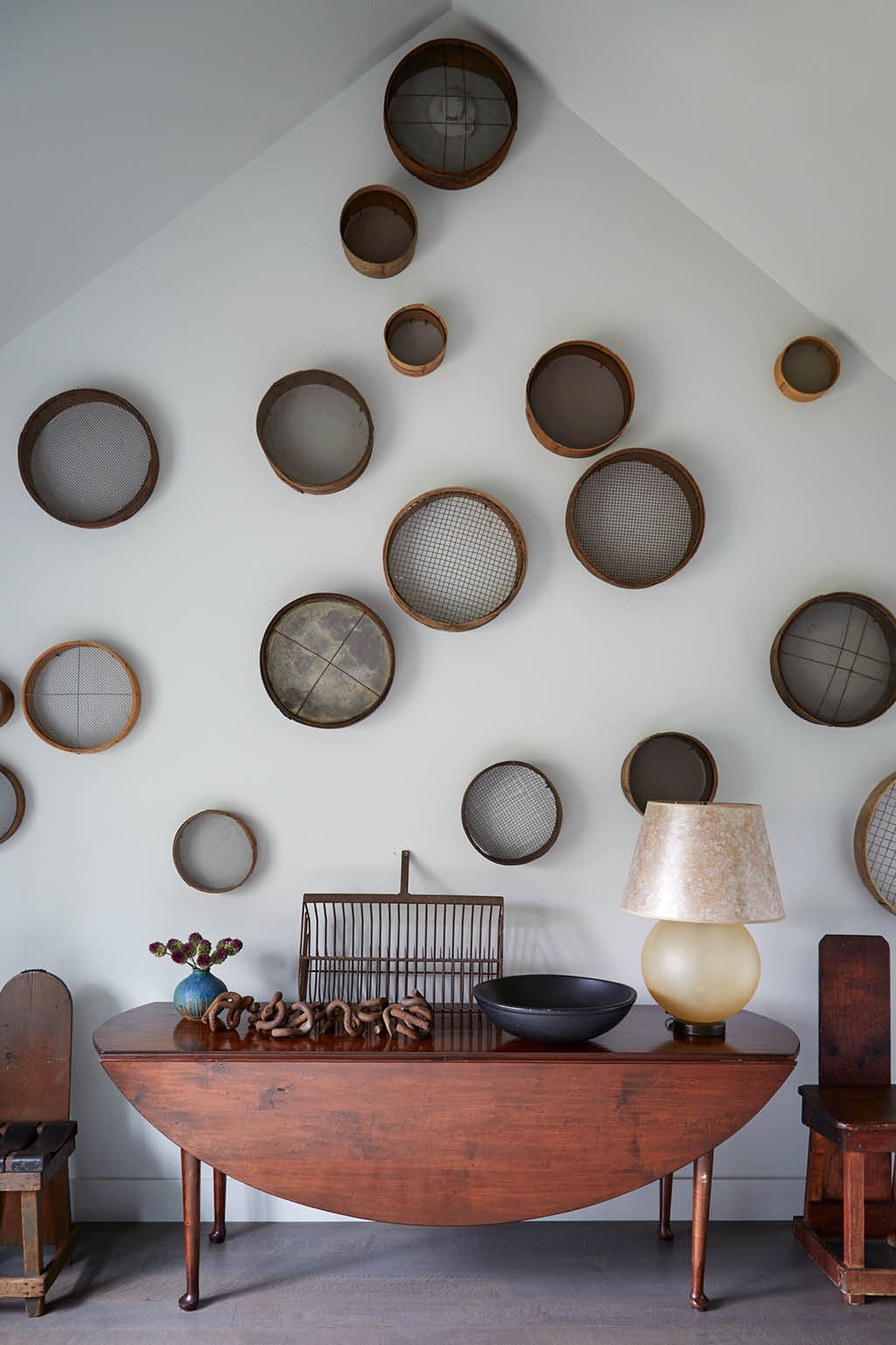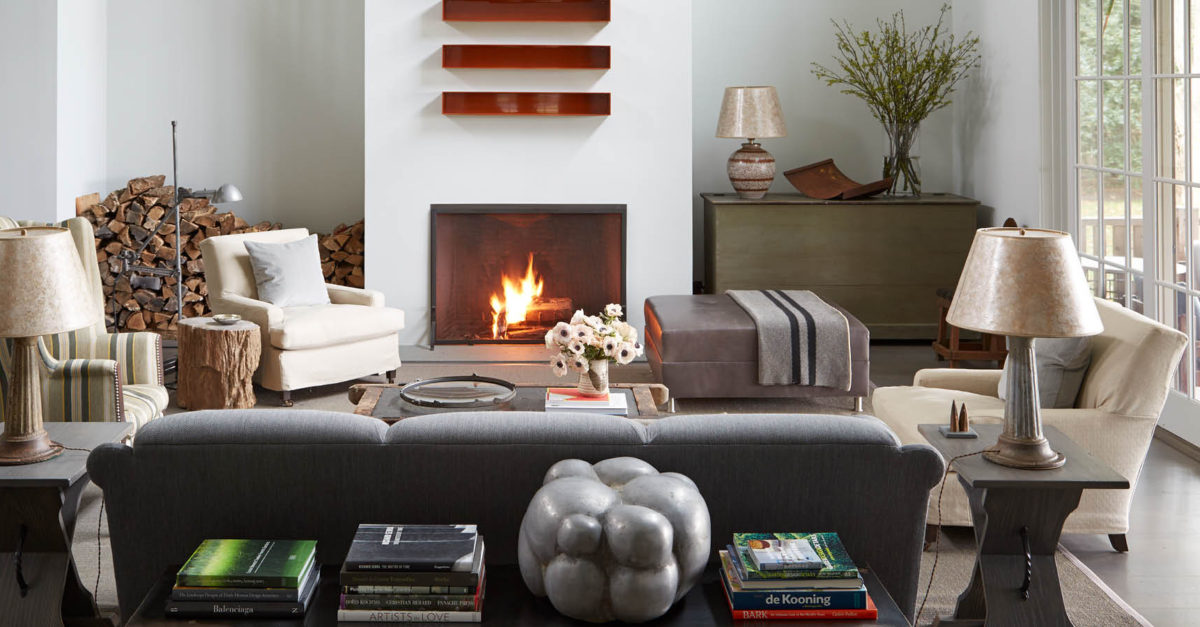Hamptons Farmhouse Rebuild: James Huniford Design Studio
As an interior designer, you’re known for having a distinctive style that combines contrasting elements (like wood and metal) and features neutral colors and crisp lines. What effects do you hope to achieve?
My sensibility is to create a balance that’s calm, soothing, and restful in every design project, whatever it is.
How much does an open flow contribute to a soothing home environment?
I believe an open flow is very important. Keeping flow top of mind with the furniture placement, the layout of the room, and the comfort level needed for the room makes the space not just pretty but also practical and functional.
How vital is client input to you?
All my work is based on my clients’ needs and lifestyles. It’s important to create a dialogue with clients to understand who they are, how they live (such as if they have kids, how they entertain, or if they host large or small groups), and what their tastes are—for example, the colors they’re drawn to, the periods of furniture they’re interested in, the lighting that’s important to them, the depth of furniture they prefer, the heights of chair seats, the table surfaces they like, and so on. The clients always come first. My job is to translate my clients’ tastes and lifestyles into a visual vocabulary for their homes. Patterns, textures, and colors are my point of view and what make up my work.
The James Huniford Design Studio is based in New York City. How does the city inspire you?
The energy in New York City is amazing, as is the design sensibility. The city is always bristling with ever-changing creativity. Visual aesthetics are always evolving, and the buildings are often being renovated. I’m inspired by what I see while walking down the street, such as the skyline and the water.
I can gaze into the window of a gallery and get an idea for a color palette in a room. Paris, London, and Rome come close as hubs for inspiration, but New York is New York.

How has the design industry changed over the years?
Some designs have become formulaic, which I find uninteresting. And clients who are drawn to my work want something that’s unique and singular, not mass-produced. I know they want something that’s hand-tailored to their personalities, their lifestyles, and their tastes.
Has your style evolved over the years?
Sure. I change it every day. The craft of design is what I love, so I’m always drawn to new things and what’s happening. But each specific element of every interior I work on is really all about that house, the setting, and the people who live there. In general, I tend to be drawn to rooms that capture the juxtaposition of refinement with ruggedness and tension—such as spaces with dark floors and light furniture or heavily weathered floors with warmer fabrics and reclaimed materials.
Speaking of unique houses and the people who live in them, tell us about the Water Mill House featured here:
It’s a weekend home in the Hamptons for two people who are both very creative. They work in the arts, and they are intensely visual, so they have a strong point of view and feeling of how they like to live. The colors they’re drawn to and their environments are very important to them. They’re really aware of the calmness of a room, its elegance, and its uniqueness. And the Water Mill House is to their personalities and their lifestyles.
Can you describe the exterior’s overall look to us?
It’s all flat cedar, and all the window frames are painted a khaki gray with a little bit of green to blend into the overall environment and the cedar roof. That was the magic of that setting and its calmness. It overlooks this amazing tree farm in the back, so, in a way, it’s like being in a forest. The light in the Hamptons is also very beautiful, and the sun sets in the back of their property, so the scenery is made up of the greens of nature and the grays and blues of the sky. That’s what I drew on for my color palette for this project.
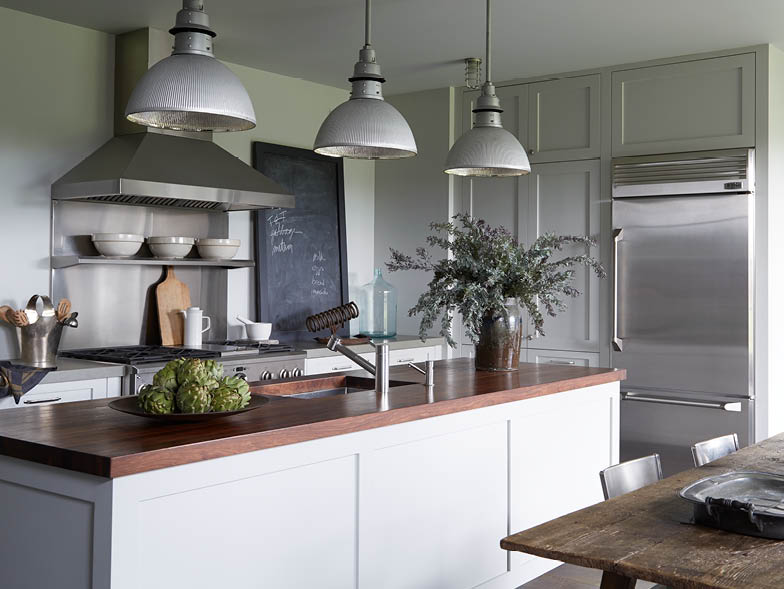
The Water Mill House was originally an early 1900s farmhouse, but it had to be rebuilt from the ground up. The owners chose to create a new barn-style home with a modern interior. Did that pose a challenge from a design standpoint?
It did. The inspiration for the design came about while I was driving with one of the clients at the time when they were thinking about what style they wanted. Along the way, I saw this barn that I loved, and I said to him, “That would be a really great exterior elevation for your new house.” So that became the launchpad for that part of the project. I didn’t want it to feel like a rustic barn on the inside, though; I wanted it to feel clean and functional but have elements of references from different periods.
When you walk into the Water Mill House, what rooms greet you?
The front door leads you right into the living room. If you walk through the side door, you enter a long hallway that has a polished concrete floor. The ceiling and walls are painted the same gray-green color. And to the right is the mudroom, which then leads you into the kitchen. Across the hall from that is the dining room, and straight ahead is the living room with a double-height ceiling. The living room is a beautiful example of your style of using wood, refined materials, muted colors, and unique elements to create a calm, yet distinctive effect.
Can you talk about some of the features in this space?
The fireplace is clearly the central feature of the living room, and the room contains other wood elements as well. The rustic coffee table is made of raw materials, including the unrefined wood and slate top; in contrast, the nearby table lamps have mica lampshades. Next to the two chairs to the left of the fireplace, you’ll notice a petrified log that serves as an end table. And I love that single vertically striped chair! One strong point of my work is that unique chairs are always in the rooms I work on. In this house, I wanted to have a modern version of a traditional or classical American wing chair.
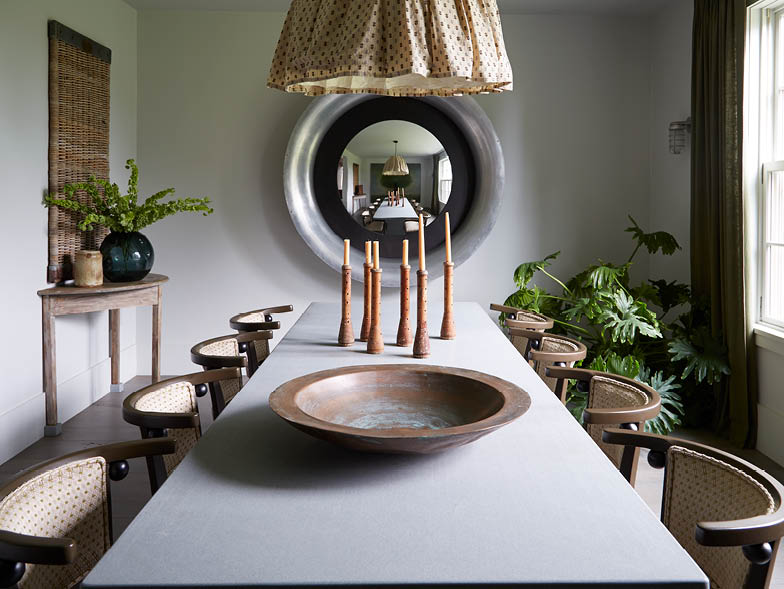
The light fixture also stands out in the living room, as does the one in the dining room. Tell us a little about those choices:
Lighting is a big part of my work. It’s an opportunity to express something that’s different, and I work really hard at finding unique light fixtures for rooms, rather than using mass-produced fixtures. The living room light fixture is all galvanized metal and bronze, and I love its sculptural shape. I love the intensity of it in a room, and that vast ceiling provided a wonderful opportunity to use something like that. And in the dining room, the light fixture was inspired by a Josef Hoffmann sensibility, with the fabric playfully pleated over a big frame. It’s unique, so you either love it or you don’t.
Of all the interesting elements in this house, the guest room may stand out the most. What were you going for in this room? Are those antique grain sifters on the wall?
I love sight lines when I walk into a room, enhancing an opportunity to expand on something that’s obvious, and taking broad strokes in my work. Incorporating the grain sifters was a great opportunity to do that. And the ceiling height and the pitch of the roofline made this room a natural fit for such a design. Art and wall installations are a big part of my work, so I don’t look at a room like it’s just about furniture and furnishings. I also consider what’s on the walls and how that relates to, and corresponds with, the rest of the room.
What was the response of the homeowners and the guests who have stayed there?
The homeowners loved the guest room. I’ve heard that people who stay think it’s a restful retreat. They don’t want to leave!
The Water Mill House also has abundant natural light. How did that affect what you did with the lighting in each of the rooms?
The clients were very interested in making sure there was adequate lighting everywhere, and I didn’t want to have any track lighting in this particular house, but instead wanted to have decorative light fixtures and great table lamps. They worked well with the light the house provided as well as the overall design.
What kind of tips would you give to a design novice?
It’s important to have an open mind and to get outside your comfort level. Be daring, be imaginative, look at art in museums and galleries, and understand what’s going on in pictures. Find the artists that you’re drawn to, and find out why you respond to them or what you relate to in their art.
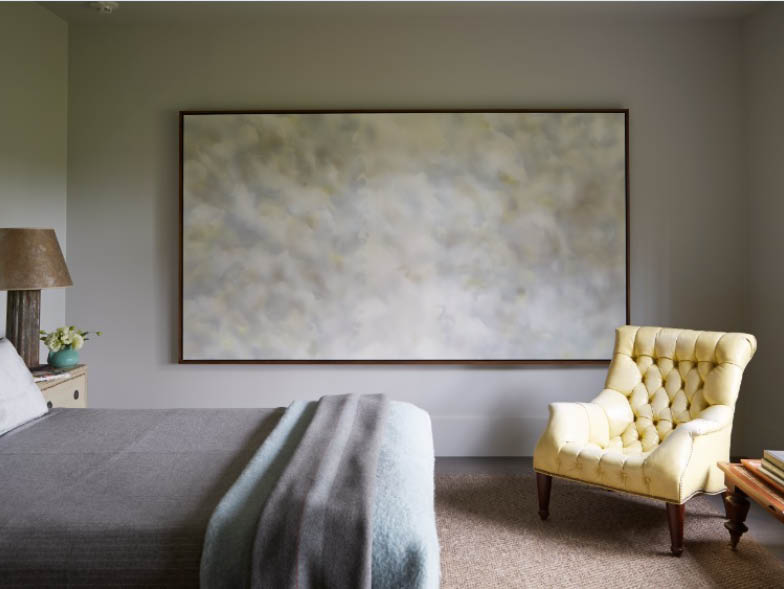
Were you drawn to any artists or designers in particular?
Michael Taylor has always been a big influence. I am drawn to his modern Northern California style with organic materials that he popularized in the 1970s and the way he advocated nontraditional placement of furniture. That has influenced my overall design sensibility. My work is not about things like fancy curtains, jumpy colors, and Oriental carpets. I try to convey calm, soothing, and luxurious sensations with touches of uniqueness.
What is your go-to color, and what is your run-from color?
My go-to colors are white, blue, and gray. And my run-from color is red. I don’t think you will ever see red in my designs, but you never know.
What’s your favorite material?
I love cotton velvet. It’s practical, it’s luxurious, and it’s comfortable.
You’ve done charity work for years. Tell us about some of the projects you’ve been involved in:
Design on a Dime is a fundraising benefit that I started ten years ago for Housing Works, an organization that houses homeless people with HIV/AIDS. It’s a great opportunity for the design community to come together and make a difference in other people’s lives. We started with five designers, and now we have seventy designers involved. It just keeps growing; we did our first Miami event this year, where we honored Lenny Kravitz for his philanthropic support and generosity. The wonderful thing is that everyone asks what we can do next to make it an even bigger success.
What can we expect next from James Huniford?
Besides my interior design projects, I’m excited that Lee Jofa, the industry leader in high-end home furnishings, has asked me to do another fabric line. I think it’s going to be a different palette, a different sensibility, and a different kind of texture.
For more info, visit huniford.com
